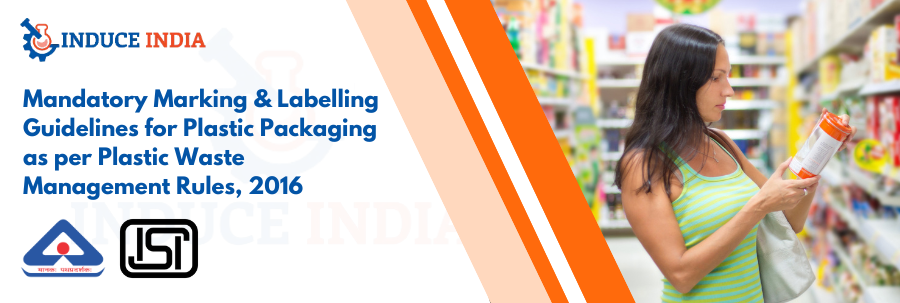Plastics are all the packaging of daily needs to a carrying bag. With growing awareness about environmental concerns and plastic pollution, India has stepped forward with some serious measures towards the regulation of plastic management, especially with respect to packaging. As Per The Plastic Waste Management (PWM) Rules, 2016, the introduction of the marking and labelling of plastic packaging should be mentioned on each category of plastic packaging material or plastic packaging of the product from 1st July 2025, which is mandatory according to the newer regime under the Plastic Waste Management (PWM) Rules, 2016.
This update is not just some bureaucratic rule; it’s going to be a game-changer in terms of post-production identification of plastics and how they are managed and recycled. This provides enforceability to the traceability of plastic waste and to its proper handling from the point of production and disposal or recycling.
Key Highlights of the Notification:
Provision 11(1): Marking or Labelling Requirements
Effective Date: July 1, 2024 / January 1, 2025
From the specified dates, the following details must be printed in English on plastic packaging:
- Name and registration certificate number of the Producer, Importer, or Brand Owner (PIBO)
(This number is generated via the centralized online portal specified in Schedule II of the Rules)
Applicable to the following categories of plastic packaging:
- Rigid plastic packaging
- Multilayer flexible plastic packaging
- Single-layer flexible plastic packaging (sachets, pouches, sheets, carry bags)
- Packaging made of compostable or biodegradable plastics
Provision 11(1A): Additional Requirements
Effective Date: July 1, 2025
From July 1, 2025, the above-mentioned information must also be:
- Printed directly on the packaging using a barcode or QR code, or
- Included in the product brochure, or
- Printed directly with the unique registration number
This move strengthens India’s efforts towards sustainable plastic waste management, making packaging more transparent and easier to monitor under the EPR (Extended Producer Responsibility) framework.
Understanding the Purpose Behind the Rules
After noticing that the Entire Plastic Watershed ran into poor management and operation in packaging, in 2016, the Indian Government set forth a series of Plastic Waste Management Rules fostering a more structured use of plastics. Updates to the regulation occurred in the years 2018 and again in 2022 for better compliance and fine-tuning of clarity.
Plastic packaging must bear marks and labels identifying the plastic item by its type, whether recyclable or not, and the manufacturer who made it. This aids in the proper sorting of plastics for recycling and contributes to greater producer accountability, which is, in turn, a matter of enforcement for Extended Producer Responsibility (EPR).
The idea is simple-if you produce or consume plastic, you also need to be responsible for the final destination of that plastic when it gets used-and labelling is the starting point of such responsibility.
What Law Demands As to Marking and Labelling
The law uses this phrase to state its compulsory requirement for any manufacturer and brand owner that employs plastic packaging: the packaging materials must be marked with certain information. Firstly, the identification code for the type of plastic must be indicated on the packaging. This is basically a number (ranging from 1 to 7) within the triangle, and seldom with letters such as PET, LDPE, HDPE, and so on. Each code corresponds to one kind of plastic; hence, it helps recyclers in segregating and thereby processing the plastic correctly.
Alongside the identification codes, the package must indicate whether it is recyclable or compostable. An indication means a lot, especially when it comes to plastic items aren’t usually bought as environmentally friendly. In the case where any product is made of compostable plastic, it has to be certified by the Central Pollution Control Board (CPCB) with the use of the compostable logo.
Similarly, the name or trade name of the manufacturer or importer should appear on the packaging for accountability. This implies that in case anything comes up about a plastic quality problem, plastic misuse, or issues with plastic waste management, the authorities can go looking for recourse or action against the producer or brand owner.
Plastic carry bags, if used, must mention the thickness of the material. The minimum thickness has thus been fixed at 120 microns for carry bags. This was done to discourage single-use thin plastic bags, which are difficult to recycle and the easiest litter on our environment.
The Role of Extended Producer Responsibility (EPR)
Extended Producer Responsibility (EPR) works toward waste minimisation through marking and labelling. It mandates producers/importers/brand owners to collect and process plastic waste arising from their products. In this way, EPR goes beyond producers and sellers of plastic products-they take responsibility for their entire life cycle.
To make the EPR work, traceability is a must; hence, the need for markings such as the type of plastic, recyclability information, and brand identification. Without such markings, the compliance of organisations remains difficult to monitor. These organisations register with CPCB or the respective State Pollution Control Board and submit EPR plans specifying how plastic waste shall be managed in respect of the products that they generate.
Who needs to follow these guidelines?
A whole gamut of stakeholders has the obligation to effectively apply these rules in the manufacture, sale, and recycling of plastic. Plastic packaging manufacturers, producers of plastic goods, brand owners using plastics for product packaging, importers of plastic-packaged goods into the country, and persons recycling or processing plastic waste must comply with these rules.
If your business is using plastic in any way, like wrapping, boxes, pouches, or bottles, even if it is not directly involved in manufacturing plastic, then these rules pertain to you. Following these rules is not a mere act of choice. It is a legal obligation that enforcers can strongly act against in the event of non-compliance.
Consequences of Non-Compliance
Non-compliance with marking and labelling guidelines can result in a number of repercussions. Fines can be imposed upon businesses under the Environment Protection Act. Under such circumstances, authorities may seize the non-compliant products. In extreme cases, suspension or revocation of the manufacturing or selling license of an organisation is possible. Further, any business failing to meet EPR obligations may be put onto a government black list, thereby depriving it of government contracts and procurement opportunities.
With awareness raised and enforcement actions being taken increasingly by both the Central Pollution Control Board and the State Pollution Control Board, non-compliance cannot just be brushed under the carpet. It goes against your brand image, your ability to continue the business, and your certification as an environmentally responsible entity.
Steps for Compliance
The first step towards compliance is to learn about the plastic used in your packaging type and verify the application of the correct identification code mark on packaging. Necessary markings for recyclability or compostability should also be included as per CPCB rules, and certification should be obtained wherever applicable.
Ensure thickness and labelling are according to packaging standards. Work with packaging vendors who know of these requirements and can incorporate them into their design and printing.
Ensure to get EPR registration under the Best EPR Consultant in India, and that timely reporting on your plastic waste management is being done. It is wise to occasionally audit your packaging to confirm that all materials are satisfactory as per present regulations.
Induce India and Sustainable Packaging Initiative
Induce India helps with all aspects of compliance, making it simpler and accessible for businesses. We serve those who are starting their sustainability initiatives as well as those already dissociating their EPR commitments and need concrete steps to follow to meet marking and labelling requirements.
We believe sustainability is not only about reducing harm but is about building better businesses ready for the future. In meeting the Plastic Waste Management Rules, we shall be assisting you in evolving into cleaner, more responsible packaging systems, which definitely do have their place in the hearts of the nation and the consumers.
Conclusion
The mandatory marking and labelling requirements as per the Plastic Waste Management Rules, 2016, stand not merely as regulations but as a responsibility. There is an environmental cost on every piece of plastic produced, and hence, the matter must be treated with utmost care right from the manufacturing stage down to its disposal.
In observance of these laws, entrepreneurs will be spared from penalties and also, narrowly focused, contemporary companies. Let’s treat packaging seriously, not just as a part of business but as an environmental concern.
If you are confused about where to begin or need assistance to make your packaging fully compliant, Induce India is at hand. Connect with us and join the journey toward a cleaner and greener future.



